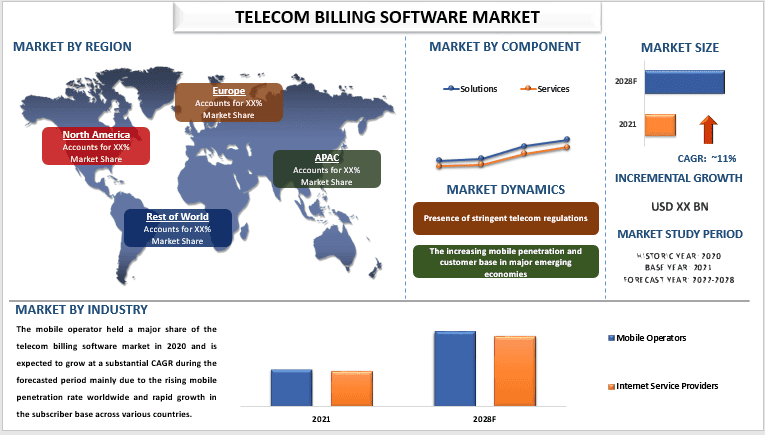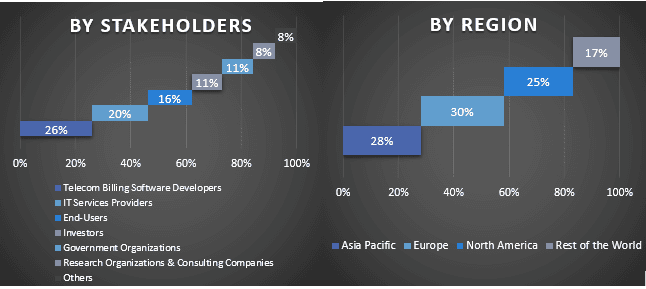- Home
- About Us
- Industry
- Services
- Reading
- Contact Us
Telecom Billing Software Market: Current Analysis and Forecast (2022-2028)
Emphasis on Component (Solutions [Billing and Charging, Revenue Assurance, Fraud Management, and Others] and Services); Deployment (Cloud and On-premises); Telecom Operator (Mobile Operators and Internet Service Providers); and Region/Country

The Telecom Billing Software Market is expected to grow at a strong CAGR of around 11% during the forecast period owing to the rapidly increasing mobile data traffic and customer base in major emerging economies. Telecom billing software is primarily designed to support the telecom billing process. It consists of a set of processes for communication service providers responsible for calculating billing and billing information, collecting consumption data, billing customers, processing payments, and managing collections. Telecom billing software works by connecting to a charging platform called an Online Charging System (OCS) that charges every transaction in real-time. Each time a device on a network interacts with the telecom system, the OCS tracks, and records that interaction based on usage and interaction type as a Call Data Record (CDR). The growing need for operators to identify and recover revenue leakages and detect frauds to deliver high-quality services is contributing to the growth of the market. In addition, the increasing mobile penetration is also contributing to the growth of the market. For instance, according to the Ericsson Mobility Report, by the end of 2028, 5G subscriptions will pass 5 billion and Fixed Wireless Access (FWA) connections will reach 300 million, where 5G will account for almost 80 percent of FWA connections.
Some of the major players operating in the market include Amdocs; CSG Systems International, Inc.; Oracle; Telefonaktiebolaget LM Ericsson; Huawei Technologies Co., Ltd.; Cerillion Technologies Limited; Comarch SA; Nokia Oyj; SAP SE; and Hewlett Packard Enterprise Development LP. Several M&As along with partnerships have been undertaken by these players to facilitate customers with hi-tech and innovative products/technologies.
Insights Presented in the Report
“Amongst component, the solutions segment held a prominent share of the market in 2021”
Based on component, the market is bifurcated into solutions and services. The solutions segment is further divided into billing and charging, revenue assurance, fraud management, and others. Amongst solutions and services, the solutions segment catered to a significant share of the market in 2021. This high share is due to the increasing adoption of billing and revenue management solutions for telecoms and the multiple benefits that come with it. Telecom billing solutions help operators assess, optimize and analyze all stages of the billing lifecycle. It helps provide complete insight and information on the revenue relationship between service providers and customers.
Telecom Billing Software Market Report Coverage

“Amongst deployment, the on-premises deployment held a prominent share of the market in 2021”
By deployment, the market is bifurcated into cloud and on-premises. Among these, the on-premises segment captured a commendable share of the telecom billing software market in 2021. On-premises systems are preferred by the majority of telecom operators because they offer significant cost benefits and the infrastructure is already in place that can be reused. There are standalone modules and integrated platforms for telecom revenue management and billing that are frequently installed on customer’s premises.
“North America held a prominent share of the market in 2021”
North America held market held a dominating share of the global telecom billing software market in 2021. This high share is mainly attributed to the elevated demand from the telecom sector and the implementation of innovative technologies in the market. Moreover, the presence of major companies operating in the telecom billing sector in the region is another factor contributing to the growth of the regional market. Additionally, the growing adoption of advanced technologies such as IoT, 5G, analytics, and cloud computing is also contributing to the growth of the market in the region.
Reasons to buy this report:
- The study includes market sizing and forecasting analysis validated by authenticated key industry experts.
- The report presents a quick review of overall industry performance at one glance.
- The report covers an in-depth analysis of prominent industry peers with a primary focus on key business financials, product portfolios, expansion strategies, and recent developments.
- Detailed examination of drivers, restraints, key trends, and opportunities prevailing in the industry.
- The study comprehensively covers the market across different segments.
- Deep dive regional level analysis of the industry.
Customization Options:
The global telecom billing software market can further be customized as per the requirement or any other market segment. Besides this, UMI understands that you may have your own business needs, hence feel free to connect with us to get a report that completely suits your requirements.
Table of Content
Research Methodology for the Telecom Billing Software Market Analysis (2022-2028)
Analyzing the historical market, estimating the current market, and forecasting the future market of the global telecom billing software market were the three major steps undertaken to create and analyze the adoption of telecom billing software in major regions globally. Exhaustive secondary research was conducted to collect the historical market numbers and estimate the current market size. Secondly, to validate these insights, numerous findings and assumptions were taken into consideration. Moreover, exhaustive primary interviews were also conducted, with industry experts across the value chain of the global telecom billing software market. Post assumption and validation of market numbers through primary interviews, we employed a top-down/bottom-up approach to forecasting the complete market size. Thereafter, market breakdown and data triangulation methods were adopted to estimate and analyze the market size of segments and sub-segments of the industry pertains to. Detailed methodology is explained below:
Analysis of Historical Market Size
Step 1: In-Depth Study of Secondary Sources:
Detail secondary study was conducted to obtain the historical market size of the telecom billing software market through company internal sources such as annual reports & financial statements, performance presentations, press releases, etc., and external sources including journals, news & articles, government publications, competitor publications, sector reports, third-party database, and other credible publications.
Step 2: Market Segmentation:
After obtaining the historical market size of the telecom billing software market, we conducted a detailed secondary analysis to gather historical market insights and share for different segments & sub-segments for major regions. Major segments are included in the report as component, deployment, and telecom operator. Further country-level analyses were conducted to evaluate the overall adoption of testing models in that region.
Step 3: Factor Analysis:
After acquiring the historical market size of different segments and sub-segments, we conducted a detailed factor analysis to estimate the current market size of the telecom billing software market. Further, we conducted factor analysis using dependent and independent variables such as component, deployment, and telecom operator of the telecom billing software market. A thorough analysis was conducted for demand and supply-side scenarios considering top partnerships, mergers and acquisitions, business expansion, and product launches in the telecom billing software market sector across the globe.
Current Market Size Estimate & Forecast
Current Market Sizing: Based on actionable insights from the above 3 steps, we arrived at the current market size, key players in the global telecom billing software market, and market shares of the segments. All the required percentage shares split, and market breakdowns were determined using the above-mentioned secondary approach and were verified through primary interviews.
Estimation & Forecasting: For market estimation and forecast, weights were assigned to different factors including drivers & trends, restraints, and opportunities available for the stakeholders. After analyzing these factors, relevant forecasting techniques i.e., the top-down/bottom-up approach were applied to arrive at the market forecast for 2028 for different segments and sub-segments across the major markets globally. The research methodology adopted to estimate the market size encompasses:
- The industry’s market size, in terms of revenue (USD) and the adoption rate of the telecom billing software market across the major markets domestically
- All percentage shares, splits, and breakdowns of market segments and sub-segments
- Key players in the global telecom billing software market in terms of products offered. Also, the growth strategies adopted by these players to compete in the fast-growing market
Market Size and Share Validation
Primary Research: In-depth interviews were conducted with the Key Opinion Leaders (KOLs) including Top Level Executives (CXO/VPs, Sales Head, Marketing Head, Operational Head, Regional Head, Country Head, etc.) across major regions. Primary research findings were then summarized, and statistical analysis was performed to prove the stated hypothesis. Inputs from primary research were consolidated with secondary findings, hence turning information into actionable insights.
Split of Primary Participants in Different Regions

Market Engineering
The data triangulation technique was employed to complete the overall market estimation and to arrive at precise statistical numbers for each segment and sub-segment of the global telecom billing software market. data was split into several segments & sub-segments post studying various parameters and trends in the areas of the as component, deployment, and telecom operator in the global telecom billing software market.
The main objective of the Global Telecom Billing Software Market Study
The current & future market trends of the global telecom billing software market were pinpointed in the study. Investors can gain strategic insights to base their discretion for investments on the qualitative and quantitative analysis performed in the study. Current and future market trends determined the overall attractiveness of the market at a regional level, providing a platform for the industrial participant to exploit the untapped market to benefit from a first-mover advantage. Other quantitative goals of the studies include:
- Analyze the current and forecast market size of the telecom billing software market in terms of value (USD). Also, analyze the current and forecast market size of different segments and sub-segments
- Segments in the study include areas of the as component, deployment, and telecom operator
- Define and analysis of the regulatory framework for the telecom billing software industry
- Analyze the value chain involved with the presence of various intermediaries, along with analyzing customer and competitor behaviors of the industry
- Analyze the current and forecast market size of the telecom billing software market for the major region
- Major countries of regions studied in the report include Asia Pacific, Europe, North America, and the Rest of the World
- Company profiles of the telecom billing software market and the growth strategies adopted by the market players to sustain in the fast-growing market
- Deep dive regional level analysis of the industry
Related Reports
Customers who bought this item also bought










